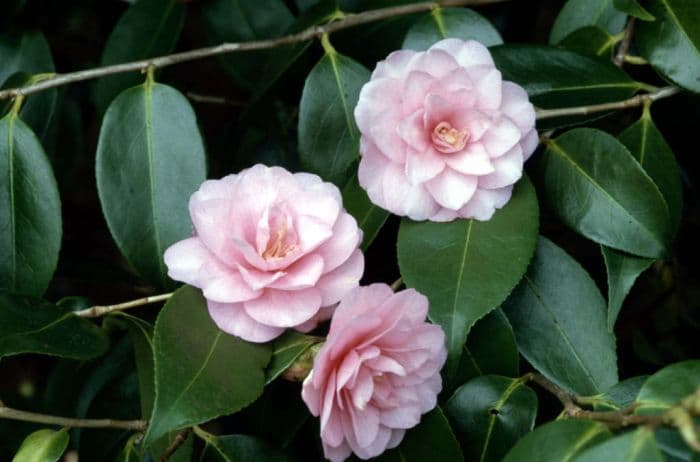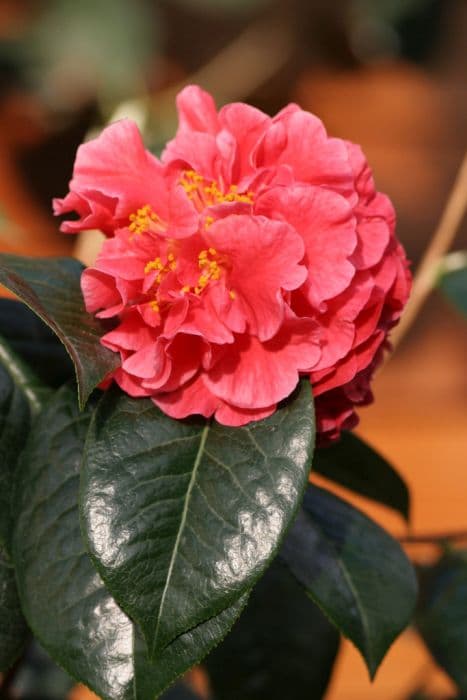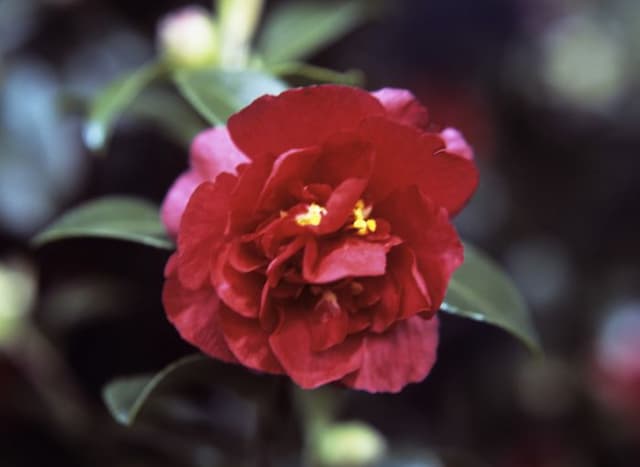Camellia Camellia 'Spring Festival' (cuspidata hybrid)

ABOUT
The Camellia 'Spring Festival' is a delightful plant known for its profusion of delicate flowers that bloom in the spring. The blossoms are soft pink with a mass of petaloids in the center, creating a peony-like effect. Each flower has a subtly ruffled appearance and presents a gentle contrast against the glossy green leaves. The leaves themselves are oval-shaped, with a leathery texture and serrated edges, contributing to the plant’s overall evergreen presentation. Frequently visited by pollinators, this camellia adds not only visual charm but also a touch of animation as bees seek out its nectar. The branches of the 'Spring Festival' are densely packed, contributing to a lush and bushy appearance, with foliage that remains attractive throughout the year.
About this plant
 Names
NamesFamily
Theaceae
Synonyms
Spring Festival Camellia
Common names
Camellia cuspidata hybrid 'Spring Festival'.
 Toxicity
ToxicityTo humans
The Camellia 'Spring Festival' is generally considered non-toxic to humans. There are no well-documented cases of poisoning from any part of this plant, which includes its leaves, flowers, and any seed pods. Consequently, there are no specific symptoms of poisoning associated with this plant. However, it is still advisable to avoid ingesting plant material that is not meant for consumption as it may cause individual allergic reactions or gastrointestinal discomfort.
To pets
The Camellia 'Spring Festival' is also typically non-toxic to pets such as dogs and cats. It does not contain any known poisonous substances that would cause harm if ingested. Therefore, if pets happen to consume parts of this plant, they are not expected to show signs of toxicity or symptoms related to poisoning. Nevertheless, as with humans, consumption of non-food plants can sometimes result in mild digestive upset, so it is still best to prevent pets from eating plants not specifically intended for them.
 Characteristics
CharacteristicsLife cycle
Perennials
Foliage type
Evergreen
Color of leaves
Green
Flower color
Pink
Height
5 feet (1.52 meters)
Spread
5 feet (1.52 meters)
Plant type
Shrub
Hardiness zones
7
Native area
Asia
Benefits
 General Benefits
General Benefits- Aesthetic Appeal: The Camellia 'Spring Festival' offers vibrant flowers that enhance the beauty of gardens and landscapes.
- Year-Round Interest: With evergreen foliage and seasonal blooms, it provides visual interest throughout the year.
- Drought Tolerance: Once established, it has a moderate tolerance to drought, reducing the need for frequent watering.
- Shade Tolerance: This plant can thrive in partial shade, making it a versatile option for different garden settings.
- Low Maintenance: It requires minimal pruning and care, making it suitable for gardeners of all skill levels.
- Wildlife Attraction: The blooms can attract pollinators such as bees, which are beneficial for the garden ecosystem.
 Medical Properties
Medical PropertiesThis plant is not used for medical purposes.
 Air-purifying Qualities
Air-purifying QualitiesThis plant is not specifically known for air purifying qualities.
 Other Uses
Other Uses- Bonsai Creation: The Camellia 'Spring Festival' can be cultivated as a bonsai, which is a traditional Japanese art of growing miniature trees.
- Natural Fabric Dye: Petals of the Camellia 'Spring Festival' can be used to produce a natural dye for fabrics, offering hues ranging from pink to a light green depending on the mordant used.
- Insectary Plant: This camellia can serve as an insectary plant by providing habitat and nectar sources for beneficial insects such as bees and butterflies.
- Photography Backdrop: The vibrant blooms and attractive foliage of the Camellia 'Spring Festival' make it an excellent backdrop for outdoor photography.
- Wedding Decor: Branches and blossoms can be used in wedding decorations, providing a natural and elegant touch to bouquets, centerpieces, and venue adornments.
- Art Inspiration: The beautiful flowers and form of the Camellia 'Spring Festival' can serve as inspiration for artists and be used as subjects in paintings and illustrations.
- Crafting: Dried camellia petals and leaves can be used in craft projects, such as creating handmade paper or floral arrangements.
- Culinary Decoration: The edible flowers can be used as a delicate garnish on desserts and other dishes, though they should be used sparingly as not all parts may be edible.
- Soil Erosion Control: When planted on slopes, the Camellia 'Spring Festival' with its evergreen foliage can help stabilize soil and prevent erosion.
- Seasonal Celebrations: The flowers are particularly associated with the Lunar New Year in some cultures and can be used to decorate homes during spring festivities.
Interesting Facts
 Feng Shui
Feng ShuiThe Camellia is not used in Feng Shui practice.
 Zodiac Sign Compitability
Zodiac Sign CompitabilityThe Camellia is not used in astrology practice.
 Plant Symbolism
Plant Symbolism- Adoration: Camellias are often associated with deep admiration and adoration, making them a perfect gift for someone who is deeply respected and loved.
- Perfection: The perfection of Camellia blossoms symbolizes the ideal state one strives to achieve in various aspects of their life.
- Longevity and Faithfulness: Due to its long blooming season, the Camellia represents enduring commitment and fidelity in a relationship.
- Refinement: The luxurious appearance of the flower signifies refinement and speaks of a person's polished and elegant nature.
- Graciousness: Camellia blossoms are a gesture of appreciation and exhibit gratitude when given as a gift.
 Water
WaterCamellias, including the 'Spring Festival' Camellia, prefer evenly moist soil, so water them thoroughly when the top inch of soil feels dry to the touch. Depending on weather conditions, this might mean watering every 5 to 7 days. Use a watering can or hose to gently apply water directly to the base of the plant, avoiding wetting the leaves to reduce the risk of disease. A mature plant typically requires about 1-2 gallons of water each week, but be sure to adjust the amount based on rainfall and temperature, as Camellias are sensitive to over-watering.
 Light
LightThe 'Spring Festival' Camellia thrives in partial shade, ideally receiving morning sunlight with protection from the intense afternoon sun. The best spot for this plant is a location where it is shielded by a larger tree or structure, ensuring it gets filtered light throughout the day. Avoid deep shade, as too little light can lead to fewer blooms.
 Temperature
Temperature'Spring Festival' Camellias are hardy and can tolerate temperatures as low as 20°F in winter and as high as 80°F in summer. However, they prefer a temperature range between 50°F and 70°F for optimal growth and bloom. Sudden frosts or very high temperatures can damage the flower buds and foliage, so avoid exposing the plant to extreme temperature fluctuations.
 Pruning
PruningPrune the 'Spring Festival' Camellia to maintain shape and improve air circulation within the plant. Pruning is best done after flowering, typically in late winter or early spring before new growth starts. Cut back any dead, damaged, or crossing branches, and thin out the plant to encourage new growth and bloom production. Pruning every year or two is typically sufficient for maintaining the health and appearance of the plant.
 Cleaning
CleaningAs needed
 Soil
SoilThe Camellia 'Spring Festival' prefers acidic soil with a pH between 5.0 and 6.5. A well-draining soil mix consisting of 50% organic material like peat moss or compost, combined with 50% perlite or pine bark, will promote healthy growth. Regularly check soil moisture to maintain consistent conditions.
 Repotting
RepottingCamellias typically require repotting every two to three years. The best time to repot Camellia 'Spring Festival' is in late winter or early spring before new growth begins.
 Humidity & Misting
Humidity & MistingCamellia 'Spring Festival' thrives in moderate to high humidity levels. Maintaining the humidity around 50% to 60% will support its growth and flower production.
 Suitable locations
Suitable locationsIndoor
Place Camellia 'Spring Festival' in bright, indirect light and keep soil evenly moist.
Outdoor
Choose a sheltered spot with partial shade and moist, acidic soil for Camellia 'Spring Festival'.
Hardiness zone
7-9 USDA
 Life cycle
Life cycleThe Camellia 'Spring Festival' begins its life cycle as a seed, which after germination, grows into a seedling under proper conditions of soil, water, and light. As the seedling matures, it develops into a young plant with a set of true leaves and becomes established. The young plant continues to grow, entering its vegetative stage where it increases in size and produces more leaves and branches. After a period of vegetative growth, it reaches maturity and enters the flowering stage, typically producing pink, peony-like flowers in late winter to early spring. Following pollination, the flowers develop into seed capsules, which eventually release seeds, completing the cycle. Throughout its life, the Camellia 'Spring Festival' will continue to grow and may experience multiple flowering cycles annually, given the right conditions and care.
 Propogation
PropogationPropogation time
Spring-Early Summer
The Camellia 'Spring Festival', a cuspidata hybrid, is most commonly propagated by semi-hardwood cuttings. The best time to take these cuttings is in late summer or early autumn, when the new growth has begun to mature. To propagate, a cutting of about 4 to 6 inches (10 to 15 centimeters) long with several leaves is taken. The lower leaves are removed, and the cut end is dipped into rooting hormone to encourage root development. The cutting is then placed into a pot filled with a mixture of peat and perlite or sand, ensuring good drainage and aeration. The pot is then covered with a plastic bag or placed in a propagator to maintain humidity, and kept at a temperature of about 70°F (21°C), away from direct sunlight. Roots typically develop within a few weeks to months, after which the new plant can be gradually acclimatized to less humid conditions and eventually planted out.









